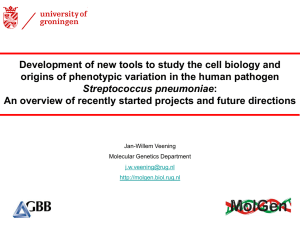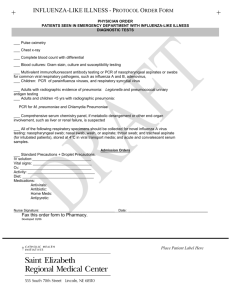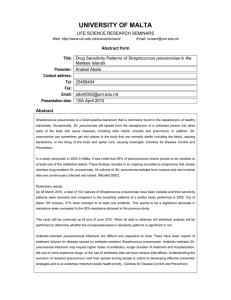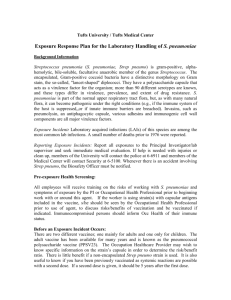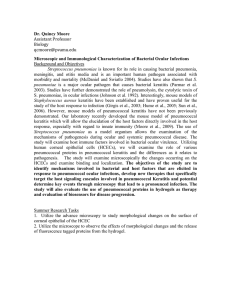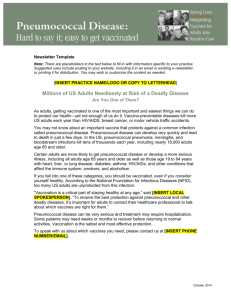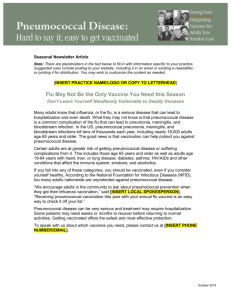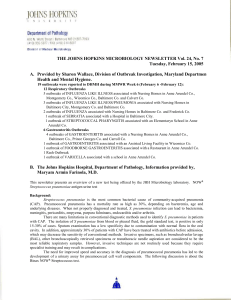Document 14233883
advertisement
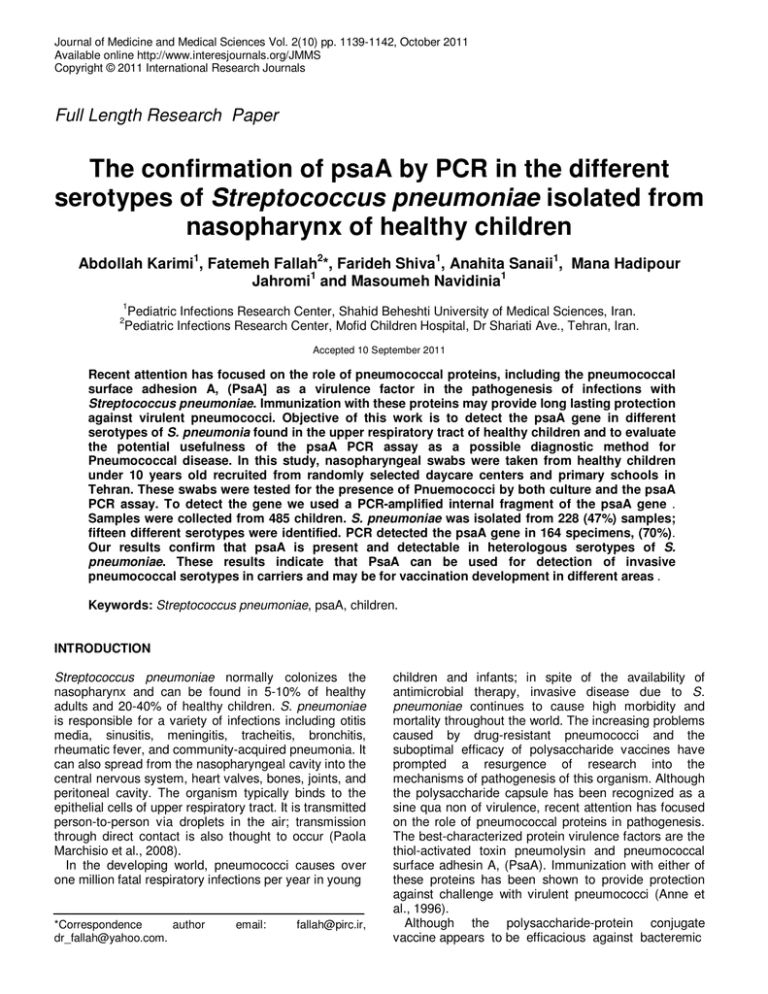
Journal of Medicine and Medical Sciences Vol. 2(10) pp. 1139-1142, October 2011 Available online http://www.interesjournals.org/JMMS Copyright © 2011 International Research Journals Full Length Research Paper The confirmation of psaA by PCR in the different serotypes of Streptococcus pneumoniae isolated from nasopharynx of healthy children Abdollah Karimi1, Fatemeh Fallah2*, Farideh Shiva1, Anahita Sanaii1, Mana Hadipour Jahromi1 and Masoumeh Navidinia1 1 Pediatric Infections Research Center, Shahid Beheshti University of Medical Sciences, Iran. Pediatric Infections Research Center, Mofid Children Hospital, Dr Shariati Ave., Tehran, Iran. 2 Accepted 10 September 2011 Recent attention has focused on the role of pneumococcal proteins, including the pneumococcal surface adhesion A, (PsaA] as a virulence factor in the pathogenesis of infections with Streptococcus pneumoniae. Immunization with these proteins may provide long lasting protection against virulent pneumococci. Objective of this work is to detect the psaA gene in different serotypes of S. pneumonia found in the upper respiratory tract of healthy children and to evaluate the potential usefulness of the psaA PCR assay as a possible diagnostic method for Pneumococcal disease. In this study, nasopharyngeal swabs were taken from healthy children under 10 years old recruited from randomly selected daycare centers and primary schools in Tehran. These swabs were tested for the presence of Pnuemococci by both culture and the psaA PCR assay. To detect the gene we used a PCR-amplified internal fragment of the psaA gene . Samples were collected from 485 children. S. pneumoniae was isolated from 228 (47%) samples; fifteen different serotypes were identified. PCR detected the psaA gene in 164 specimens, (70%). Our results confirm that psaA is present and detectable in heterologous serotypes of S. pneumoniae. These results indicate that PsaA can be used for detection of invasive pneumococcal serotypes in carriers and may be for vaccination development in different areas . Keywords: Streptococcus pneumoniae, psaA, children. INTRODUCTION Streptococcus pneumoniae normally colonizes the nasopharynx and can be found in 5-10% of healthy adults and 20-40% of healthy children. S. pneumoniae is responsible for a variety of infections including otitis media, sinusitis, meningitis, tracheitis, bronchitis, rheumatic fever, and community-acquired pneumonia. It can also spread from the nasopharyngeal cavity into the central nervous system, heart valves, bones, joints, and peritoneal cavity. The organism typically binds to the epithelial cells of upper respiratory tract. It is transmitted person-to-person via droplets in the air; transmission through direct contact is also thought to occur (Paola Marchisio et al., 2008). In the developing world, pneumococci causes over one million fatal respiratory infections per year in young *Correspondence author dr_fallah@yahoo.com. email: fallah@pirc.ir, children and infants; in spite of the availability of antimicrobial therapy, invasive disease due to S. pneumoniae continues to cause high morbidity and mortality throughout the world. The increasing problems caused by drug-resistant pneumococci and the suboptimal efficacy of polysaccharide vaccines have prompted a resurgence of research into the mechanisms of pathogenesis of this organism. Although the polysaccharide capsule has been recognized as a sine qua non of virulence, recent attention has focused on the role of pneumococcal proteins in pathogenesis. The best-characterized protein virulence factors are the thiol-activated toxin pneumolysin and pneumococcal surface adhesin A, (PsaA). Immunization with either of these proteins has been shown to provide protection against challenge with virulent pneumococci (Anne et al., 1996). Although the polysaccharide-protein conjugate vaccine appears to be efficacious against bacteremic 1140 J. Med. Med. Sci. infections with pneumococci, it will not protect against capsular types not included among the conjugates comprising the vaccine; and the vaccine is likely to be too expensive for widespread use in the developing world. Moreover, despite the fact that the polysaccharide-protein conjugate vaccines elicit modest protection against carriage, they have not been reported to eliminate carriage in humans, or in a mouse model. To provide adequate herd immunity and widespread protection in the developing world, a new or modified vaccine will be needed. One possibility is to use protection-eliciting cross-reactive pneumococcal proteins as immunogens (David et al., 2000) An epidemiological assessment is required to identify the common serotypes of S. pneumoniae in the nasopharynx of healthy children. This information is necessary for defining the pattern of antibiotic resistance and for the production of an effective vaccine. We performed this study to determine the presence of the psaA gene in pneumococcal serotypes isolated from the nasopharynx of healthy children aged under ten years. METHODS AND MATERIALS Study Design and Subjects This was a cross-sectional study. 485 healthy children were recruited from randomly selected daycare centers and primary schools in Tehran. Children with the following conditions were excluded from the study: chronic illnesses, Immunologic diseases, Neoplastic disorders, or kidney, heart, liver, and hematologic diseases, Down syndrome, chronic otitis media and severe upper or lower respiratory infections. Flexible mini culturette Becton Dickinson swabs angled at 30 degrees were placed into the nasopharynx up to 1-2 cm depth for 5 s avoiding any contact with tongue or uvula. Swabs were immediately transferred to Stuart transport environment (Venturi, Transystem Brescia, Italy) and delivered to the laboratory within three hours. S. pneumoniae was identified through standard procedures, (Bacteriology 7 diagnostic Fine Gold, 4). Because our specimen size was small (20 µl), we incorporated an enrichment step before the PCR assay to improve sensitivity. Preparation of bacterial DNA DNA to be amplified was released from whole organisms by boiling. Bacteria were harvested from 1 ml of an overnight broth culture, suspended in 200 mL of sterile water, and incubated at 100°C for 10 min. Following centrifugation of the lysate, a 149-pI sample of the supernatant was stored at -20°C as a template. Oligonucleotides used as primers were obtained from the sequences of the DNA fragments, single-stranded DNA templates were prepared by the polyethylene glycol method, and the nucleotide sequence was determined by dideoxynucleotide chain termination. Amplification procedure PCR was done in a total volume of 50 pL containing 10 pA of the template DNA, each of the primers at 0.45 puM, the four deoxynucleoside triphosphates (each at 200 pM), 10 mM Tris hydrochloride (pH 8.3), 1.5 mM MgCl2, 50 mM KCl, 0.01% gelatin, and 1.2 U of AmpliTaq DNA polymerase. The reaction mixture was overlaid with 3 drops of mineral oil. PCR amplifications consisted of 25 cycles of denaturation at 94°C for 2 min, annealing at 65°C for 1 min, and extension at 72°C for 2 min in a Thermal Cycler (Eppendorrf). Electrophoresis Ten microliters of the reaction mixture was then analyzed by electrophoresis on 2% agarose gels, and the reaction products were visualized by staining with ethidium bromide. A reagent blank, which contained all components of the reaction mixture, except the template DNA, was included in every PCR procedure (Brito et al., 2003). Statistical analysis Prevalence rates with 95% confidence intervals (CIs) were calculated for the study sample and comparison subgroups. Comparisons were made between categorical variables using χ2 test of proportions or, in the case of small samples, Fisher’s exact test, with P # .05 being the priori significance level. Multiple logistic regression was used to evaluate the possibility of confounding. RESULTS Out of 458 nasopharyngeal samples, S. pneumoniae was isolated from 228, (47%) samples (24 different serotypes). The different serotypes which have been isolated from 458 nasopharyngeal samples were: (11.86%) 19–(10.12%) 6-(9.59% ) 14–(7.32%) 17– (6.9%) 20–(6.8%) 23–(/6.10%) 21-( 5.23%) 11-(5.06%) 33–(4.88% non typable (4.71%) 22-(4.01%) 16-(3.31%) 25-(1.91%) 10-(1.74%) 35–(1.74%) 1–(1.74%) 27– (1.39%) 41–(1.39%) 47-(1.39%) 7–(1.22%) 5–(0.87%) 36–(0.17%) 8–(0.17% ) 9–(0.17% ). In this study, we found the genetic presence of psaA by PCR analysis in some of S. pneumonia serotypes (22 serotypes: 1,5,6,7,8,10,11,14,16,17,19,20,21,22,23,25,27,33,35,36 Karimi et al. 1141 Figure 1. The prevalence of streptococcus pneumonia from nasopharyngeal swab in healthy children Figure 2 . The prevalence of serotypes including psaA from S. pneumonea isolated from nasopharyngeal swab in healthy children. ,41,47). PCR detected the psaA gene in 164 cases (22 different serotypes) that means 70% were positive for the psa Antigen (See Figures 1 and 2). DISCUSSION This study confirms the genetic presence of psaA by PCR analysis in some of S. pneumoniae serotypes (22 serotypes: 1, 5, 6, 7,) and demonstrates the potential usefulness of the PCR assay for detecting the psa antigen in epidemiologic studies in order to determine the presence of S. pneumonia. It supports and expands on the previous immunoblot studies, which demonstrated the presence of PsaA epitopes among 90 serotypes by using monoclonal antibodies.7 A protein common to all 22 serotypes with genetic and immunologic similarity has implications both for vaccine studies and diagnostic development. The generation of amplified products of comparable size implies similarity in the gene size and, in turn, gene product and is indicative of a common and highly similar protein .The use of an immunogenic common protein as a vaccine immunogen or carrier could eliminate the need for multiple capsular types in a pneumococcal vaccine and additionally elicit a memory response, which occurs only with protein-based vaccines . S. Pneumococcal diagnostic assays are based primarily on detection of pneumococcal antigens, DNA, or RNA in blood or body fluids. Although blood culture is currently the most accurate method by which to diagnose pneumococcal disease, only approximately 30% of specimens test positive with this method (Laval et al., 2006). Since many patients with pneumococcal disease have received antibiotics for treatment, any available specimens would contain only nonviable organisms, thus the culture would be negative. Conventional serologic methods lack uniform diagnostic sensitivity and specificity and are time-consuming because they require reagents in which all serotypes are represented. Therefore, there is a need for a highly 1142 J. Med. Med. Sci. sensitive and highly species-specific method of detection that will make diagnosis of pneumococcal disease less complicated. Our study suggests that the psaA PCR assay is highly specific, as indicated by the lack of amplification of heterologous bacteria, even the viridans group of streptococci. Other PCRs reported in the literature have not been widely adapted for use in the clinical laboratory because they have not been shown to be consistently and uniformly sensitive (Tseng et al., 2002). For example, Jaime et al. (2005) described the necessity of testing three different blood fractions to maximize sensitivity. They also suggested that a combination of other diagnostic methods is needed for diagnosis of invasive pneumococcal disease. The sensitivity (1,400 fg of purified DNA) of the psaA PCR assay needs further evaluation and improvement before use of the assay in broad clinical applications (i.e., with blood or lung aspirates). Although we have not addressed the problems of specimen size, type, or preparation, a more sensitive assay should be achievable by making modifications in components and/or conditions of the assay and by definitively determining the appropriate sample or specimen type (Jaime et al., 2005). CONCLUSION In conclusion, by demonstrating the presence of the gene (psaA) among the 22 serotypes, we offer an additional option for developing new assays for the detection of Pneumococci. We also illustrate the potential of the psaA PCR assay for use in epidemiologic studies for identification of S. pneumoniae and for diagnosis of pneumococcal disease. Future studies will include improvement of the sensitivity of the assay as well as examination of other clinical samples (i.e., blood, sputum, and lung aspirates). To validate diagnostic usefulness of psaA amplification. It should prove to be a valuable method identification and diagnosis of S. pneumoniae for use in clinical and epidemiologic studies .Our results confirm that psaA is present and detectable in heterologous serotypes of S. pneumoniae. These results indicate that PsaA can be used for detection of invasive pneumococcal serotypes in carriers and may be for vaccination development in different areas . ACKNOWLEDGEMENTS This study was supported by the Pediatric Infections Research Centre (PIRC) in Mofid Children’s Hospital in Tehran. We are grateful to the Iran National Science Foundation (INSF) for financial support. REFERENCES Anne MB, James C.P (1996). Sequence Heterogeneity of PsaA, a 37Kilodalton Putative AdhesinEssential for Virulence of Streptococcus pneumonia.INFECTION AND IMMUNITY, Dec. 64 (12): 5255– 5262. Brito DA, Ramirez M, de Lencastre H (2003). Serotyping Streptococcus pneumoniae by multiplex PCR. J. Clin. Microbiol. Jun. 41 (6): 2378-84. Caroline O, Jack S, Deepak K, Ernesto H, Theresa B, Elaine I. Tuomanen, Carlos JO (2006). Identification of a Candidate Streptococcus pneumoniae Core Genome and Regions of Diversity Correlated with Invasive Pneumococcal Disease. INFECTION AND IMMUNITY, Aug. 74 (8): 4766–4777. David EB, Eddie A, James CP, Jacquelyn S. Sampson, George M. Carlone, Robert C. Huebner, Anni V, Edwin S, Susan KH (2000). Intranasal Immunization of Mice with a Mixture of the Pneumococcal Proteins PsaA and PspA Is Highly Protective against Nasopharyngeal Carriage of Streptococcus pneumonia. Infect. Immun. February 68(2): 796–800. Jaime M, Elkin H, Olga S, Elizabeth C (2005). Detection and Serotyping of Streptococcus pneumoniae from Nasopharyngeal Samples by PCR-Based Multiplex Assay J. Clin. Microbiol. December 43 (12): 6152–6154. 7-Katherine E. Morrison, Derrick Lake, Jennifer Crook, George M. Carlone, Edwin Ades, Richard F, Jacquelyn SS (2000).Confirmation of psaA in All 90 Serotypes of Streptococcus pneumoniae by PCR and Potential of This Assay for Identification and Diagnosis. Journal of Clinical Microbiology, January 38 (1): 434-437 Laval CB, de Andrade AL, Pimenta FC, de Andrade JG, de Oliveira RM, Silva SA, de Lima EC, Fabio JL Casagrande ST, Brandileone MC (2006). Serotypes of carriage and invasive isolates of Streptococcus pneumoniae in Brazilian children in the era of pneumococcal vaccines. Clin. Microbiol. Infect. Jan. 12 (1):50-5 Paola M, Susanna E, Gian CS, Anna M, Roberta C, Nicola P, Hercules (2008). Nasopharyngeal Carriage of Streptococcus pneumoniae in Healthy Children: Implications for the Use of Heptavalent Pneumococcal Conjugate Vaccine.J.Infect. May 56 (5): 332-339 Tseng H, MacEwan AG, Paton JC, Jenning MP (2002). Virulence of Streptococcus Pneumoniae: PsaA mutants are hypersensitive to oxidative stress. Infect. Immun. March 70 (3): 1635-1639.
